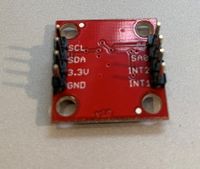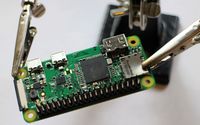Difference between revisions of "Headband Helper"
Jump to navigation
Jump to search
| Line 46: | Line 46: | ||
[[File: Acc_header.jpeg|200px|thumb|right|Accelerometer with Pins]] | [[File: Acc_header.jpeg|200px|thumb|right|Accelerometer with Pins]] | ||
[[File: Pi_header.jpeg|200px|thumb|right|Pi with Pins]] | [[File: Pi_header.jpeg|200px|thumb|right|Pi with Pins]] | ||
| + | *Step 2: Wire the Pi to the accelerometer as shown in the following diagram. IMPORTANT: The shape of the accelerometer is slightly different, but the pins still go to the corresponding ports (e.g., GROUND will still to GPIO pin 9). Additionally, instead of VCC, connect to the 3.3v port on the accelerometer. | ||
| + | *[[File: wiring|300px]] | ||
=== Module 2: Build Ad Hoc Network === | === Module 2: Build Ad Hoc Network === | ||
Revision as of 16:46, 3 April 2019
Contents
Links
Presentation [1]
GitHub Repository [2]
Project Proposal
Overview
We hope to construct an accelerometer-based concussion monitoring system using a Raspberry Pi OW that can be contained within a headband. In addition, we will create a web interface that allows users to track their impact history. These two pieces (software and hardware) will communicate using an ad hoc IP network run by another Raspberry Pi.
Team Members
- Jarrod Huther
- Katy Mockett
- TA: Ethan Shry
- Professor: James Feher
Objectives
- Create an accelerometer-based concussion monitoring system that can be contained within a headband
- Create an ad hoc IP network using a master Raspberry Pi to collect data from the headbands
- Ensure that the master Pi and web interface can successfully communicate so the web interface can display collected data about collisions
Challenges
- We both have limited experience with circuitry
- We both are comfortable working in Java but have never really used any languages beyond Java
- No experience with sensor networks; creating a fully debugged network will be difficult
Budget
- 2 accelerometers ($11.95 each, $23.90 total)[3]
- Shipping (~$8.00)
- 1 Amp battery & charger ($24.95)[4]
- Raspberry Pi 0W- headband (free)
- Raspberry Pi- master (free)
- 3D box to contain tracking materials within headband (free)
Total Budget: $56.85
Gantt Chart
Design and Solutions
Module 1: Wiring Accelerometer to Pi 0
- Module 1 of our project involves wiring the H3LIS331DL accelerometer to the Raspberry Pi 0. This specific accelerometer is 3-axis, meaning it records data in the x, y, and z-planes, and can take readings up to +-400g's. We chose this board specifically because concussion occur at approximately 91g's, while other forces in a respective sport can reach much higher than that.
- Step 1: Solder header pins onto both the accelerometer and the pi (if not already attached).
- Step 2: Wire the Pi to the accelerometer as shown in the following diagram. IMPORTANT: The shape of the accelerometer is slightly different, but the pins still go to the corresponding ports (e.g., GROUND will still to GPIO pin 9). Additionally, instead of VCC, connect to the 3.3v port on the accelerometer.
- 300px


